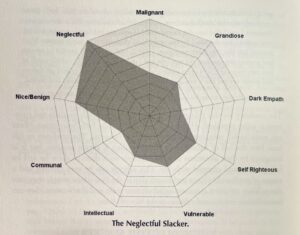
Riso & Hudson (1991) call this Personality Subtype “The Comfort Seeker” [see a general overview of the Nine personality style here]:
“In the average range, this variant is a pleasant, easygoing Nine who does not ask much from life. Self-Preservation Nines prefer simple pleasures that are readily available—eating good food, especially food that is easy and quick to prepare, watching a favourite rerun on television, or “zoning out” in a comfy chair.”
We are usually not that ambitious, although we can be quite talented. We generally deal with anxiety by getting involved in busy work—puttering and routines—and may use small tasks to avoid dealing with bigger projects. We often become increasingly attracted to minor rewards as compensation for not being able to pursue our real desires— and generally there will be some repressed underlying anxiety about not attending to our more fundamental needs.
A CONCRETE PERSONALITY STYLE
Us Self-Preservation Nines are generally very “concrete” people, oriented towards immediate experience, who don’t relate much to abstractions or metaphysical concepts (although Nines with a One wing, “The Dreamers”, will sometimes have this aspect to them).
As Self-Preservation Nines there is usually less innate “psychological mindedness” and introspection, and more focus on tangible and immediate “things to do”. We find experiences much easier to deal with than theory. We can also often struggle to put our own experiences into words, and prefer not to talk a lot about what is going on inside us in general.
Naranjo (1991) describes the meaning behind “Appetite” as a kind of excessive “creature-likeness,” characterized by an “I eat therefore I am” or an “I sleep therefore I am” attitude that erases the question of “being” in a larger sense. For us SP Nines, the ordinary facts of life get in the way of thinking about abstract things, like what might be lacking in our experience. We are people who live life in a more simple and direct way, and this is generally how we like things to remain.
More than the other two Type Nine subtypes, us Self-Preservation Nines also tend to want more time alone. Like other Nines, we too can habitually focus our attention on other people and on our environment, but we also find it much more relaxing and grounding to be by ourselves, as it allows us to more fully relax into whatever activity we are engaged with.
Like other Nines are very loving people, but deep down we usually don’t have the sense of being loved. It’s as if we have resigned ourselves to not actively receiving love for ourselves. For us Self-Preservation Nines, the search for comfort in pleasurable activities may reflect a desire for compensation for our deeper sense of abnegation. The jolliness or fun-loving spirit of our type is very real though, and a very endearing characteristic of our personality style, as well as functioning as another kind of compensation for an early lack: we can often feel the need to substitute fun for love.
For this reason, we tend to be active and intuitive, expressing a kind of subtle strength in everything we do. We are the most “Eight-ish” of the three Nine subtypes. Our sense of inertia with regard to taking action places us more firmly in the Ninth Dimension, so we are unlikely to be mistaken for Eights who don’t do this. But in our own quiet and peaceful way, we do have a fairly forceful energy, especially in contrast to the Sexual Nine, who is often a much less assertive character.
Us Self-Preservation Nines can thus have a stronger presence than the other two Nine subtype personalities, and for this reason, we can also be more irritable and stubborn. It can be very difficult for us to accept that another person is right or may have a point with something we are conflict with them about.
WHAT WE STRUGGLE WITH
Nines’ inertia (the Achille’s Heel of the 9th dimension) shows up most clearly in our self-preservation variant. Apathy and self-neglect can cause us Self-Preservation Nines to have difficulty mobilising ourselves to obtain what we really want or even to take care of all our genuine self-preservation needs [read more about the Self-Preservation instinct here]. Increasingly, we might use food/drink/routines to suppress feelings of anxiety or anger and can sometimes struggle with various forms of addictive behaviour.
We generally do not want our pleasant moods to be disturbed by others and can often resist others simply by not responding to them, remaining stubbornly silent.
In the unhealthy range, we Self-Preservation Nines can fall into deep apathy about our lives and can become fatigued and ineffectual. We can even become the chronic couch potatoes, emotionally shut down and slowly wasting away our health, relationships, and possibilities. Addictions are not uncommon for us.
Wagner (2010) points out that when the personality Achilles Heel of the Nine (indolence, indecisiveness, apathy) leaks into the self-preservation instinct “appetite can get divorced from satisfaction and can become out of control, being pursued for its own sake”. Binge-eating or drinking, shopping sprees, trips to the casino, or carrying out our various self-care routines in a rigid and uncompromising fashion are conflict-resolving strategies for us SP Nines, allowing us to numb out while appearing to be active.
We often deal with anger and anxiety through appetite, trying to either drown these feelings or stuff them away. Our egoic functioning can often focus on inconsequential things in the belief that we need these for survival, replacing true needs and desires with non-essentials. Unfortunately these wishes and routines don’t fulfil the real self, which still experiences a hunger that never was and still isn’t fulfilled.
GOING TO THE “LOW SIDE” OF OUR PERSONALITY TYPE
Sterlin Mosely (2022) with his somewhat caustic wit calls us Self-Pres Nines “Neglectful Slackers” when we go to the low side of our personality type.

Mosley notes that the less pleasant and “nice” side to us Self-Preservation Nines is often hidden (both from ourselves and others) and is more challenging to detect due to our propensity to undervalue ourselves and our importance as a feature of our overall personality structures.
He also notes that SP9s, especially when in a state of stress, can sometimes become “incredibly dismissive of others’ concerns, taking the the phrase don’t sweat the small stuff (and its all small stuff) to a whole new level, and stubbornly refusing to be bothered by anyone or anything.”
Mosley suggests that it can be useful for those who are in relationship with us to take the following tack when dealing with our way of being in the world:
- Avoid disrupting our routines too much, as this is when you’ll get the most pushback from our subtype. Instead, suggest variations or deviations from our norm and let us decide whether or not to adopt these.
- When ourr subtype is at its worst, we can be exceptionally neglectful and callous. Remember, this stems from our own self-neglect, and you must for this reason prioritize your own emotional needs because we are unlikely to do so for you.
- We SP9s can often cut corners, be reticent, or even downright miserly about putting forth more energy or effort than we need to. Getting into a conflict with us will only make us dig in our heels even more. It’s best to just leave us alone when we are upset, carry on and find ways to give yourself what you need. Silence is the best language when dealing with an SP9. If you allow us to retreat and find our stillness and composure once more, we will reconnect in time with you.
- If we become frustrated, dismissive or angry, it’s best to leave us alone rather than to get into conflict. We are hugely conflict-avoidant, and when pushed to engage with conflict, the depth of our rage (if it ever emerges, and it probably won’t, as we fear our own anger) can be explosive and destructive.
INNER-WORK FOR SELF-PRESERVATION NINES
Dr. Jerome Lubbe, a Functional Neurologist summarises some general bio-psycho-spiritual steps we can take as Nines to reach our full potential.
This begins by recognising that our innate nature is directed towards PEACE, our innate motivation is that of SERENITY, and our innate gift in terms of what humanity can learn from us is that of REST.
In order to promote these strengths, he suggests:
- Meditating with the specific intention of embodiment (body scanning, somatic experiencing, focused movement, etc)
- Engaging in weight-bearing, fine-motor, body-based exercises such as: Tai Chi, Yoga, Qi Gong, Jiu Jitsu, etc
- Practicing focused 4-7-8 breath work (as we breathe, count to 4, hold for 7, breathe out for 8)
- Walking 15-17,000 steps per day (Begin with 1K and increase as our body allows).
- Prioritizing Emotional Intelligence and Mental Health.
In terms of brain-activation, he suggests the following three reflection questions which we might ask ourselves on a daily basis:
- What positive actions can I take in response to the serenity I experience? How can I make that serenity more of an active force? [This targets brain-stem activation which is the “source” of of our personality style]
- What does a healthy emotional relationship with serenity mean to me? [Right Brain – intentional activation]
- What are the specific moments today where have I encountered life-giving serenity? How can I pragmatically encourage more experiences like this? [Left Brain – intentional activation]
When we are overwhelmed, fatigue often expresses as panic quickly followed by a Flight/Freeze response. Consider the following:
- How do I respond when my sense of peace and steadiness is threatened? (Is this reaction appropriate. Am I aware of my breath in these moments?)
- How do I respond when conflict and neglect are present? (Is this reaction appropriate? Am I aware of my breath?)
- Practicing stillness externally (possibly with others) and engaging in breath awareness.
More specifically, we Self-Preservation Nines can travel the path from our Achilles’ Heel of apathy and inaction to “right” action or wisdom by making conscious contact with our anger and being more proactive in thinking through, tapping into, and acting from our own clearly-defined self-interests.
Feeling and working with our anger instead of avoiding it can help us connect more thoroughly with our passion and our power; and if we have more awareness of our anger we can then connect to an inner sense of strength and fortitude that will help us to get what we want instead of giving up on it and losing ourselves.
If we can find a way to go for what we want in more direct ways, we can fulfil our deeper desires and bolster our inner sense of being instead of distracting ourselves from its absence.
Being more directly in touch with our power and passion also allows us to open up more to being loved and having the kind of connections that nurtures us instead of the pseudo-connections we normally satisfy ourselves with because our “acorn-self” thinks these are all we can get.
Instead of the “empty calories” of our comfortable activities and our enmeshed relationships, allowing ourselves to feed our appetite for love and presence by accessing our emotions, taking in real love, and making more conscious connections seems to be the path for us Nines out of our ego cages, giving us more access to happiness, health, and well-being.

